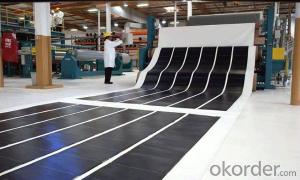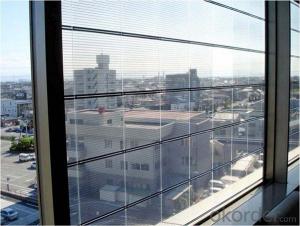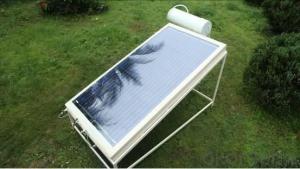Thin Film Solar Cell with TUV/ UL/ CE/ RoHS/ IEC/ CQC/ ISO/ SFEC/ CEC Approval
- Loading Port:
- Tianjin
- Payment Terms:
- TT or LC
- Min Order Qty:
- 10 unit
- Supply Capability:
- 500 unit/month
OKorder Service Pledge
OKorder Financial Service
You Might Also Like
Specifications
Thin film solar system energy yield per Wp can be 10% higher than that of silicon solar system due to material characterics.
Amorphous silicon thin film solar panel, with TUV/ UL/ CE/ RoHS/ IEC/ CQC/ ISO/ SFEC/ CEC approval.Framed by black anodized aluminium, easy to fix or made into free standing type. AmpleSun ASF series have many advantages with high quality production process and raw materials:
General advantages:
1. Good environment adaptability, less sensitive to installation angle, more suitable for vertical installation in BIPV.
2. Excellent performance.
3. 30% lighter than double-glass type.
4. Framed with aluminium makes ASF more solid.
5. Good looking, well match the buildings or as a constituent part.
6. Free from defects for 5 year with regular use, maintain more than 90% of Max. power for 10 years and 80% for 25 years.
Technical advantages:
1. Low temperature coefficient:
Normally, the electricity performance of photovoltaic module is measured by STC standard. However, the temperature of solar module, operating in the sun, can be much higher than atmosphere temperature.
With the temperature increase, module power will decrease accordingly. Temperature coefficient for thin film silicon solar cell is 0.2%/0c, and that of crystalline solar cell is -0.5%/0c. That means, when the module is worked on 500c condition, compare to the efficiency reached on 250c test standard , thin film silicon solar module will loose around 5%, and the loss for crystalline will be around 12.5%.
In conclusion, even the STC efficiency of thin film silicon solar cell is low, the efficiency in actual operation condition is not far away to that of crystalline solar cell.
2. Good weak light performance:
The performance of thin film silicon solar cell is better than that of crystalline solar cell in the weak light condition.
Solar power system with crystalline solar module will not generate power in the late afternoon. However, solar power system with thin film silicon solar cell still generates power.
Furthermore, thin film silicon has gentle current-voltage curve. This characteristic makes it easier to pick-up the most electricity power.
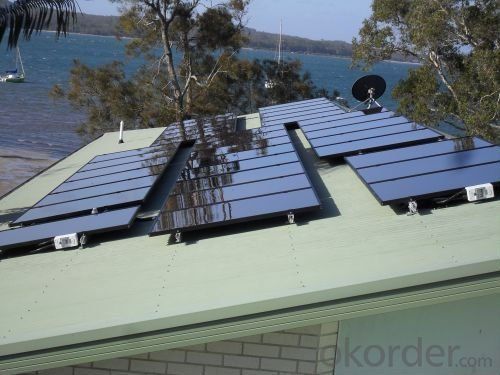
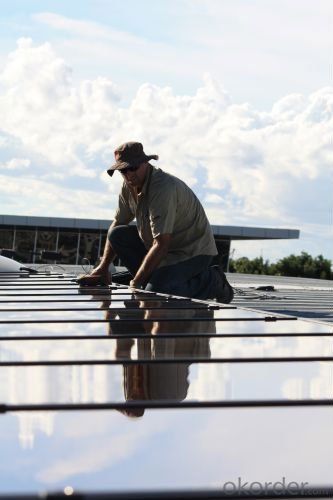
Brief introduction of Thin Film Solar Cell
Thin film solar cells can be made up with inexpensive ceramics, graphite, metal sheets of different materials as substrates. The film thickness can be formed to generate a voltage of just a few μm; the highest conversion efficiency of the thin film solar cell can be up to 13% currently.
Physical Advantage of Thin Film Solar Cell
Now the main material of thin film solar cell is silicon. In the share of the cost of the finished solar cells, silicon materials accounted for nearly 40%. The thickness of amorphous silicon solar cells is less than 1μm, which is less than 1/100 of the thickness of crystalline silicon solar cells, reducing the manufacturing cost greatly. Since the amorphous silicon solar cell manufacturing low temperature (-200 ℃), is easy to realize the advantages of a large area, so that it takes primacy in the thin film solar cell, the manufacturing methods in electron cyclotron resonance method, photochemical vapor deposition method, DC glow discharge, radio frequency glow discharge method, sputtering method and Xie hot-wire method. Especially the RF glow discharge method because of its low temperature process (-200 ℃), easy to implement large-scale and high-volume continuous production, is now internationally recognized as a mature technology. Especially the RF glow discharge method because of its low temperature process (-200 ℃), easy to implement large-scale and high-volume continuous production, is now internationally recognized as a mature technology. In materials research, has studied a-SiC window layer, graded interface layer, μC-SiC p layer, etc., and significantly improves the short-wave spectral response of the cell. This is due to the a-Si solar photo-generated carriers generated mainly in an i-layer, i-layer before reaching the incident light is absorbed by the p-layer portion of the power is invalid. The a-SiC and μC-SiC material than the p-type a-Si has a wider optical band gap, thus reducing the absorption of light that reaches the light increases the i-layer; gradient interface layer coupled with improved a- transport properties of SiC / a-Si heterojunction interface photoelectrons in response to increase in the long-wave, using a suede TCO film, a multi-layer suede back reflection electrode (ZnO / Ag / Al) and multi-bandgap stacked structure, That glass / TCO / p1i1n1 / p2i2n2 / p3i3n3 / ZnO / Ag / Al structure. Suede TCO film and the electrode multilayer back reflector reduces light reflection and transmission losses and an increase in the propagation of light from the i layer, thereby increasing the light absorption in the i-layer multi-band-gap structure, with the i-layer gap width begin to gradually decrease from the light incident direction to absorb sunlight segment reached broaden the spectral response, the purpose of improving the conversion efficiency. Improving the efficiency of the battery stack also features graded bandgap design, tunnel junctions of microcrystalline doped layer, so as to improve the carrier collection.
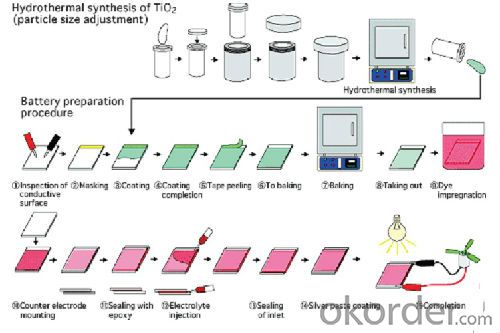
- Q:Want to use solar panels and batteries to produce a power supply that can provide a stable voltage, how can you connect? Can you connect directly with the solar panel to the battery while the battery power supply is feasible?
- Solar cells and battery connection, it is best to use a photovoltaic charging controller, which can control the output voltage of solar cells can protect the battery is not overcharge, but also at night when the solar cell does not generate electricity, to prevent the battery power back
- Q:Are solar cells environmentally friendly?
- Yes, solar cells are environmentally friendly. They generate electricity by harnessing the sun's energy, which is a clean and renewable source of power. Solar energy production does not produce greenhouse gas emissions, air pollution, or create hazardous waste. Additionally, solar cells have a long lifespan and can be recycled at the end of their life, minimizing their environmental impact.
- Q:My solar cells are broken, can I just buy one and replace it?
- No, you just can not do properly
- Q:Can solar cells be used in theme parks or amusement parks?
- Yes, solar cells can definitely be used in theme parks or amusement parks. They can be installed to generate clean and renewable energy to power various attractions, lighting, and facilities within the park. Solar cells are a sustainable and cost-effective solution that can help reduce the carbon footprint of theme parks and contribute towards a greener environment.
- Q:Friends are fuel cells are chemical energy into electricity, solar cells are converted into electricity into electricity I would like to know in addition to the structure and the conversion of different ways there are no other differences hope that the specific power of everyone
- In general, the fuel cell has the following characteristics: (1) high energy conversion efficiency He will directly convert the chemical energy of fuel into electricity, the middle without the combustion process, and thus not limited by the Carnot cycle.
- Q:How do solar cells impact energy poverty?
- Solar cells can greatly alleviate energy poverty by providing access to clean and affordable electricity to communities without reliable power grids. Solar energy is a sustainable and renewable source that can be harnessed even in remote areas, reducing dependence on fossil fuels and expensive fuel imports. This technology empowers individuals and businesses to generate their own electricity, improving quality of life, supporting economic development, and enabling access to essential services such as lighting, education, healthcare, and communication.
- Q:What is the impact of solar cells on job creation?
- Solar cells have had a significant positive impact on job creation, both in the manufacturing and installation sectors. The growing demand for renewable energy has led to a surge in solar cell production, creating new manufacturing jobs and stimulating economic growth. Additionally, the installation and maintenance of solar panels have created numerous job opportunities, especially in the construction and engineering industries. As the solar industry continues to expand, it is expected to further contribute to job creation and foster a sustainable and green economy.
- Q:Can solar cells be used for powering electric vehicles in motion?
- Yes, solar cells can be used for powering electric vehicles in motion. Solar panels can be installed on the roof or any other surface of the vehicle to harness sunlight and convert it into electricity. This electricity can be used to charge the vehicle's batteries while it is moving, supplementing the power from the grid or reducing reliance on it. However, the efficiency of solar cells and limited surface area on vehicles may pose challenges in meeting the entire power demand of electric vehicles solely through solar energy. Nonetheless, solar technology has the potential to contribute to the overall power supply of electric vehicles, making them more sustainable and reducing their carbon footprint.
- Q:Can solar cells be used in schools or educational institutions?
- Yes, solar cells can definitely be used in schools or educational institutions. They provide a practical and hands-on way to teach students about renewable energy sources, sustainability, and environmental stewardship. Installing solar cells in schools can also help reduce electricity costs and promote energy efficiency, making it a beneficial investment for educational institutions.
- Q:Can solar cells be used in swimming pool heating?
- Yes, solar cells can be used in swimming pool heating. By capturing sunlight and converting it into electricity, solar cells can power a pool heating system, providing an eco-friendly and cost-effective way to warm up the pool water.
1. Manufacturer Overview |
|
|---|---|
| Location | |
| Year Established | |
| Annual Output Value | |
| Main Markets | |
| Company Certifications | |
2. Manufacturer Certificates |
|
|---|---|
| a) Certification Name | |
| Range | |
| Reference | |
| Validity Period | |
3. Manufacturer Capability |
|
|---|---|
| a)Trade Capacity | |
| Nearest Port | |
| Export Percentage | |
| No.of Employees in Trade Department | |
| Language Spoken: | |
| b)Factory Information | |
| Factory Size: | |
| No. of Production Lines | |
| Contract Manufacturing | |
| Product Price Range | |
Send your message to us
Thin Film Solar Cell with TUV/ UL/ CE/ RoHS/ IEC/ CQC/ ISO/ SFEC/ CEC Approval
- Loading Port:
- Tianjin
- Payment Terms:
- TT or LC
- Min Order Qty:
- 10 unit
- Supply Capability:
- 500 unit/month
OKorder Service Pledge
OKorder Financial Service
Similar products
New products
Hot products
Hot Searches
Related keywords

